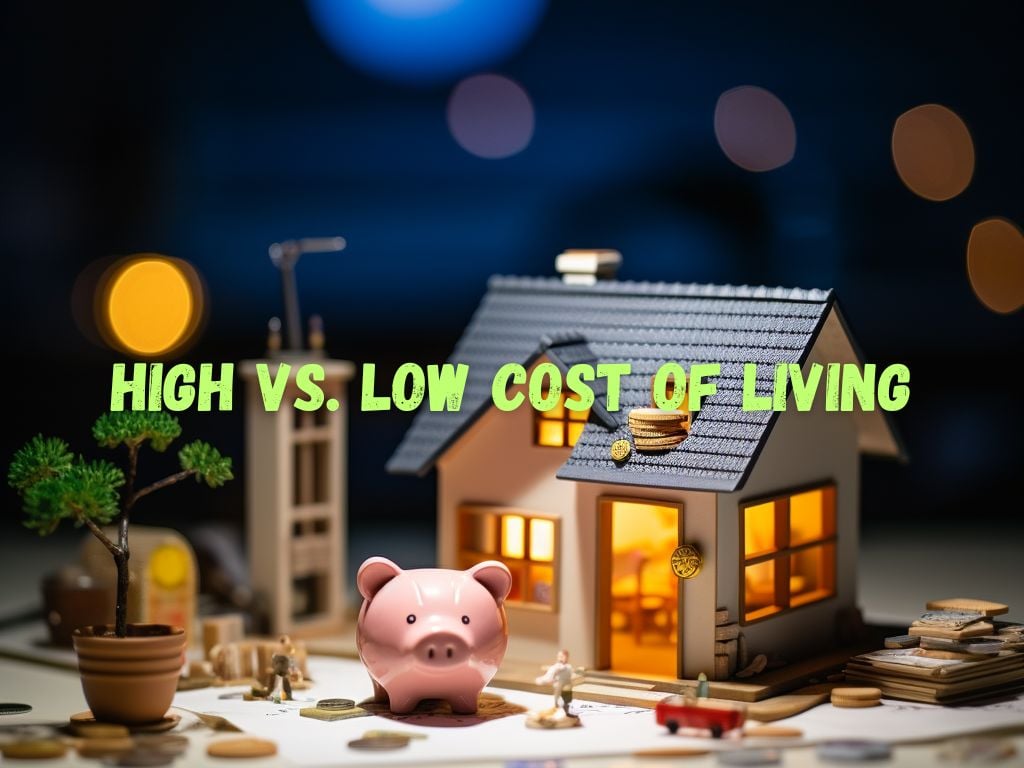When considering where to live, one crucial aspect to consider is the cost of living.
Some areas have a higher cost of living (HCOL), while others have a lower cost of living (LCOL).
In this article, we will address the debate of HCOL vs LCOL areas, and the implications they have for our budgets and lifestyles.
Definition of HCOL and LCOL
HCOL and LCOL are terms used to describe the relative expenses associated with living in a particular area.
HCOL areas typically have higher housing prices, transportation costs, healthcare expenses, and overall living expenses.
On the other hand, LCOL areas generally offer lower costs in these areas.

Factors Affecting HCOL and LCOL Areas
Several factors influence whether an area is classified as HCOL or LCOL:
Housing prices and rental costs:
The biggest contributor to the cost of living is housing.
In HCOL areas, housing prices and rents are significantly higher than in LCOL areas. Demand for housing and limited supply drive up prices in HCOL regions.
Transportation expenses:
The cost of transportation can vary greatly between HCOL and LCOL areas. HCOL regions often have more extensive public transportation networks, but costs can be higher due to densely populated areas and congestion.
LCOL areas may have fewer transportation options, requiring car ownership and potentially lower expenses.
Healthcare and insurance costs:
Access to healthcare and the cost of health insurance can differ across regions. HCOL areas may offer superior healthcare facilities but at a higher cost.
LCOL areas may have more affordable healthcare options but could be limited in terms of access and specialized services.
Grocery and food prices:
The price of groceries and dining out can fluctuate depending on the region.
Generally, HCOL areas have higher grocery costs, while LCOL areas offer more affordable options.
However, local factors such as availability and transportation costs can impact prices.
Entertainment and leisure expenses:
HCOL areas typically provide a wider range of entertainment options, such as theaters, museums, and high-end restaurants.
These options come at a premium and can significantly impact your budget. LCOL areas may have fewer luxurious options but can still provide affordable recreational activities.
Taxes and living expenses:
Taxes play a significant role in determining the overall cost of living.
HCOL areas often have higher taxes to support the infrastructure and services they provide.
On the other hand, LCOL areas tend to have lower taxes, which can be advantageous for those looking to reduce their expenses.

Pros and Cons of HCOL Areas
Living in a HCOL area has its advantages and drawbacks.
Understanding these can help you make an informed decision:
Higher job opportunities and salaries:
HCOL areas often offer more job opportunities, especially in industries such as finance, technology, and media.
Alongside these opportunities come higher salaries, which can offset the higher costs associated with living in these areas.
Better infrastructure and amenities:
HCOL areas tend to have better infrastructure, including public transportation systems, schools, and healthcare facilities. These amenities can enhance your quality of life, but they come at a higher price.
Cultural and entertainment options:
HCOL areas offer a vibrant cultural scene with numerous entertainment options, including theaters, music venues, and museums.
If you appreciate art, theater, and nightlife, HCOL areas provide ample opportunities to indulge your interests.
Higher taxes and living expenses:
One significant drawback of HCOL areas is the higher cost of living.
Housing, transportation, and everyday expenses can quickly add up, leaving less disposable income.
Higher taxes, including income tax and property tax, are an additional burden.
Increased competition and cost of housing:
HCOL areas attract many people due to the opportunities they offer.
This leads to increased competition for housing, resulting in soaring housing prices and limited availability. Finding an affordable home can be challenging in these areas.
Pros and Cons of LCOL Areas
If you prioritize affordable living, LCOL areas may be more appealing.
Let’s explore the advantages and drawbacks:
Lower housing costs and property prices:
One of the biggest advantages of LCOL areas is the affordable housing market.
Home prices and rental costs are significantly lower, allowing you to save money or afford more spacious accommodations.
Reduced living expenses and taxes:
LCOL areas generally have lower living expenses. Groceries, transport, and other everyday costs are often cheaper, allowing you to stretch your budget further.
Additionally, lower taxes mean you can retain more of your income.
Less competition for jobs and housing:
LCOL areas may not be as competitive as HCOL areas when it comes to job opportunities and housing.
This can provide a more relaxed lifestyle with less competition and potentially more employment options.
Limited job opportunities and lower salaries:
While LCOL areas offer a lower cost of living, they may not provide as many job opportunities or highly lucrative careers.
Industries and job sectors may be limited, and salaries may be lower compared to HCOL areas.
Potential lack of amenities and cultural offerings:
LCOL areas may have limited amenities, such as shopping centers, cultural institutions, and entertainment options. If access to a wide array of amenities and cultural experiences is important to you, a LCOL area might not fulfill your desires.

HCOL vs LCOL: Key Factors to Consider When Choosing The Right Area
When deciding whether to choose an HCOL vs LCOL area, several factors should be considered:
Personal financial goals and priorities:
Evaluate your financial goals and how living expenses can align with those goals. Determine how much you are willing to spend on housing, transportation, and other expenses.
Career prospects and opportunities:
Consider your career aspirations and the potential for job growth and employment opportunities in each area.
Research industries and companies that are prevalent in HCOL or LCOL cities to determine if they align with your desired career path.
Lifestyle preferences and priorities:
Your lifestyle preferences play a significant role in where you choose to live.
Consider factors such as proximity to family and friends, outdoor activities, cultural offerings, and the pace of life.
Economic stability and future prospects:
Evaluate the economic stability and potential future prospects of each area.
Research the local economy, industry trends, and development plans to assess the long-term prospects of living in an HCOL or LCOL area.
Frequently Asked Questions
What is the difference between HCOL and MCOL?
HCOL areas have a significantly higher cost of living compared to MCOL (Moderate Cost of Living) areas. MCOL areas offer a middle ground, with expenses falling somewhere between HCOL and LCOL regions.
Is Boston considered HCOL?
Yes, Boston is typically considered an HCOL area. The city offers a high quality of life, extensive amenities, and a competitive housing market, all contributing to elevated living expenses.
Is Alaska a HCOL area?
While Alaska’s cost of living can vary depending on the city or region, some parts of the state are considered HCOL areas.
Factors such as limited accessibility and high transportation costs can contribute to higher living expenses.

Conclusion
Choosing between HCOL and LCOL areas involves a careful analysis of various factors.
Assessing your financial goals, career prospects, lifestyle preferences, and economic stability can help you make a well-informed decision.
Consider both the advantages and drawbacks of HCOL and LCOL areas to determine which living environment aligns best with your budget and lifestyle.
Remember, there is no definitive answer as to which is better – it ultimately depends on your unique circumstances and priorities.


 Tags:
Tags:










